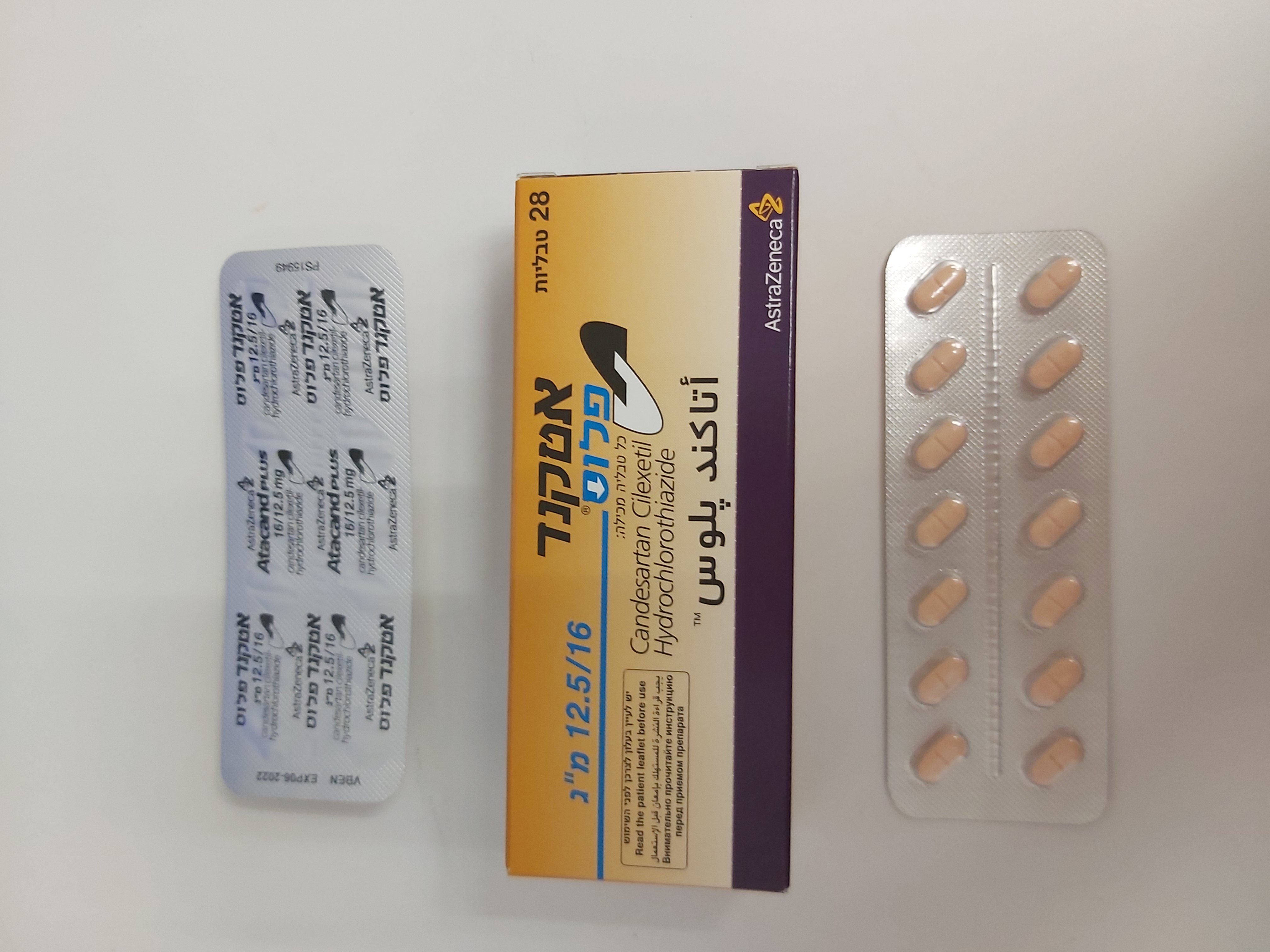Quest for the right Drug

אטקנד פלוס ATACAND PLUS ® (CANDESARTAN CILEXETIL, HYDROCHLOROTHIAZIDE)
תרופה במרשם
תרופה בסל
נרקוטיקה
ציטוטוקסיקה
צורת מתן:
פומי : PER OS
צורת מינון:
טבליה : TABLETS
עלון לרופא
מינוניםPosology התוויות
Indications תופעות לוואי
Adverse reactions התוויות נגד
Contraindications אינטראקציות
Interactions מינון יתר
Overdose הריון/הנקה
Pregnancy & Lactation אוכלוסיות מיוחדות
Special populations תכונות פרמקולוגיות
Pharmacological properties מידע רוקחי
Pharmaceutical particulars אזהרת שימוש
Special Warning עלון לרופא
Physicians Leaflet
Interactions : אינטראקציות
4.5 Interaction with other medicinal products and other forms of interaction Substances that have been investigated in clinical pharmacokinetic studies include warfarin, digoxin, oral contraceptives (i.e. ethinylestradiol/levonorgestrel), glibenclamide and nifedipine. No pharmacokinetic interactions of clinical significance were identified in these studies. It can be expected that the potassium-reducing effect of hydrochlorothiazide is potentiated by other drugs associated with potassium loss and hypokalaemia (e.g. other diuretics, laxatives, amphotericin, carbenoxolone, penicillin G-sodium, salicylic acid derivatives, steroids, ACTH). Concomitant use of Atacand Plus and potassium-sparing diuretics, potassium supplements or salt substitutes or other medicinal products that can raise serum potassium levels (e.g. heparin sodium and the combination trimethoprim/sulfamethoxazole) may lead to increased serum potassium levels. Potassium levels should be monitored as needed (see Section 4.4). Diuretic-induced hypokalaemia and hypomagnesaemia predispose the potential cardiotoxic effects of digitalis glycosides and antiarrhythmics. Regular monitoring of serum potassium is recommended when Atacand Plus is administered together with such drugs and with the following drugs that can induce torsades de pointes: • Class IA antiarrhythmic (e.g. quinidine, hydroquinidine, disopyramide) • Class III antiarrhythmics (e.g. amiodarone, sotalol, dofetilide, ibutilide) • Certain antipsychotics (e.g. thioridazine, chlorpromazine, levomepromazine, trifluoperazine, cyamemazine, sulpiride, sultopride, amisulpride, tiapride, pimozide, haloperidol, droperiodol) • Others (e.g. bepridil, cisapride, diphemanil, i.v. erythromycin, halofantrine, ketanserin, mizolastine, pentamidine, sparfloxacin, terphenadine, i.v. vincamine) Concomitant administration of lithium and ACE inhibitors or hydrochlorothiazide has been reported to cause reversible increases in serum concentration and lithium toxicity. A similar effect has also been reported with AIIRA. The use of candesartan and hydrochlorothiazide together with lithium is not recommended. Close monitoring of serum lithium levels is recommended if this combination proves necessary. When AIIRA is co-administered with non-steroidal anti-inflammatory drugs (NSAIDs) (i.e. selective COX-2 inhibitors, acetylsalicylic acid (> 3 g/day) and non-selective NSAIDs), a reduction in the antihypertensive effect may occur. As with ACE inhibitors, concomitant use of AIIRA and NSAID may lead to an increased risk of impaired renal function, including possible acute renal failure and an increase in serum potassium, especially in patients with already diminished renal function. The combination should be given with caution, especially to the elderly. These patients must receive sufficient hydration and monitoring of renal function upon initiation of the combination treatment and regularly thereafter is recommended. The diuretic, natriuretic and antihypertensive effects of hydrochlorothiazide are reduced by NSAIDs. Absorption of hydrochlorothiazide is reduced by colestipol and cholestyramine. The effect of non-depolarizing skeletal muscle relaxants (e.g., tubocurarine) can be enhanced by hydrochlorothiazide. Thiazide diuretics may increase serum calcium levels due to decreased excretion. If calcium or vitamin D supplements are prescribed, serum calcium levels should be monitored and the dose adjusted accordingly. The hyperglycemic effect of beta blockers and diazoxide may be potentiated by thiazides. Anticholinergic agents (e.g. atropine, biperiden) can work to increase the bioavailability of thiazide diuretics by reducing gastrointestinal motility and gastric emptying rate. Thiazides may increase the risk of side effects caused by amantadine. Thiazides can reduce the renal excretion of cytotoxic drugs (e.g., cyclophosphamide, methotrexate) and enhance their myelosuppressive effects. Postural hypotension may be potentiated by concomitant use of alcohol, barbiturates or anaesthetics. Treatment with a thiazide diuretic may impair glucose tolerance. Dose adjustment of antidiabetics, including insulin, may be necessary. Metformin should be used with caution due to the risk of lactic acidosis triggered by possible functional renal failure associated with hydrochlorothiazide. Hydrochlorothiazide may reduce the arterial response to pressor amines (e.g., adrenaline) but not enough to reverse the pressor effect. Hydrochlorothiazide may increase the risk of acute renal insufficiency, especially in high doses of contrast agents containing iodine. Concomitant treatment with cyclosporine may increase the risk of hyperuricaemia and gout-like complications. Concomitant treatment with baclofen, amifostine, tricyclic antidepressants or neuroleptics may lead to a potentiation of the antihypertensive effect and may cause hypotension. Data from clinical trials have shown that the incidence of adverse events such as hypotension, hyperkalaemia and impaired renal function (including acute renal failure) is higher in double blockade of the renin-angiotensin-aldosterone system (RAAS) through the combined use of ACE inhibitors, angiotensin II receptor blockers or aliskiren, compared to the use of a single RAAS inhibitor drug (see Sections 4.3, 4.4 and 5.1).

פרטי מסגרת הכללה בסל
התרופה האמורה תינתן לחולים הסובלים מיתר לחץ דם או אי ספיקת לב הסובלים בנוסף מרגישות לטיפול בתכשירים השייכים למשפחת מעכבי ACE או שפיתחו תופעות לוואי לטיפול כאמור
מסגרת הכללה בסל
התוויות הכלולות במסגרת הסל
| התוויה | תאריך הכללה | תחום קליני | Class Effect | מצב מחלה |
|---|---|---|---|---|
| OLMESARTAN MEDOXOMIL | ||||
| VALSARTAN | ||||
| LOSARTAN | ||||
| IRBESARTAN | ||||
| CANDESARTAN | ||||
| טיפול בחלבון בשתן מתחת ל-1 גרם ומעל ל-30 מ"ג, עבור חולה שלא סובל מיתר לחץ דם או אי ספיקת לב, הסובל בנוסף מרגישות לטיפול בתכשירים השייכים למשפחת מעכבי ACE או שפיתח תופעות לוואי לטיפול כאמור. | ||||
| חולה הסובל מפרוטאינוריה מעל 1 גרם, בשילוב עם מעכבי ACE | ||||
| חולה הסובל מיתר לחץ דם או אי ספיקת לב הסובל בנוסף מרגישות לטיפול בתכשירים השייכים למשפחת מעכבי ACE או שפיתח תופעות לוואי לטיפול |
שימוש לפי פנקס קופ''ח כללית 1994
לא צוין
תאריך הכללה מקורי בסל
01/03/2002
הגבלות
תרופה מוגבלת לרישום ע'י רופא מומחה או הגבלה אחרת
מידע נוסף
